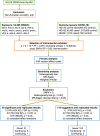Extensive Mendelian randomization study identifies potential causal risk factors for severe COVID-19
- PMID: 35602208
- PMCID: PMC9053245
- DOI: 10.1038/s43856-021-00061-9
Extensive Mendelian randomization study identifies potential causal risk factors for severe COVID-19
Abstract
Background: Identifying causal risk factors for severe coronavirus disease 2019 (COVID-19) is critical for its prevention and treatment. Many associated pre-existing conditions and biomarkers have been reported, but these observational associations suffer from confounding and reverse causation.
Methods: Here, we perform a large-scale two-sample Mendelian randomization (MR) analysis to evaluate the causal roles of many traits in severe COVID-19.
Results: Our results highlight multiple body mass index (BMI)-related traits as risk-increasing: BMI (OR: 1.89, 95% CI: 1.51-2.37), hip circumference (OR: 1.46, 1.15-1.85), and waist circumference (OR: 1.82, 1.36-2.43). Our multivariable MR analysis further suggests that the BMI-related effect might be driven by fat mass (OR: 1.63, 1.03-2.58), but not fat-free mass (OR: 1.00, 0.61-1.66). Several white blood cell counts are negatively associated with severe COVID-19, including those of neutrophils (OR: 0.76, 0.61-0.94), granulocytes (OR: 0.75, 0.601-0.93), and myeloid white blood cells (OR: 0.77, 0.62-0.96). Furthermore, some circulating proteins are associated with an increased risk of (e.g., zinc-alpha-2-glycoprotein) or protection from severe COVID-19 (e.g., prostate-associated microseminoprotein).
Conclusions: Our study suggests that fat mass and white blood cells might be involved in the development of severe COVID-19. It also prioritizes potential risk and protective factors that might serve as drug targets and guide the effective protection of high-risk individuals.
Keywords: Epidemiology; Genetic association study.
© The Author(s) 2021.
Conflict of interest statement
Competing interestsThe authors declare no competing interests.
Figures




Similar articles
-
Causal Associations of Obesity With Achilles Tendinopathy: A Two-Sample Mendelian Randomization Study.Front Endocrinol (Lausanne). 2022 Jun 14;13:902142. doi: 10.3389/fendo.2022.902142. eCollection 2022. Front Endocrinol (Lausanne). 2022. PMID: 35774146 Free PMC article.
-
Causal Effects of Overall and Abdominal Obesity on Insulin Resistance and the Risk of Type 2 Diabetes Mellitus: A Two-Sample Mendelian Randomization Study.Front Genet. 2020 Jul 2;11:603. doi: 10.3389/fgene.2020.00603. eCollection 2020. Front Genet. 2020. PMID: 32714368 Free PMC article.
-
White Blood Cells and Severe COVID-19: A Mendelian Randomization Study.J Pers Med. 2021 Mar 12;11(3):195. doi: 10.3390/jpm11030195. J Pers Med. 2021. PMID: 33809027 Free PMC article.
-
The causal effect of obesity on diabetic retinopathy: A two-sample Mendelian randomization study.Front Endocrinol (Lausanne). 2023 Apr 3;14:1108731. doi: 10.3389/fendo.2023.1108731. eCollection 2023. Front Endocrinol (Lausanne). 2023. PMID: 37077358 Free PMC article.
-
Causal relationship among obesity and body fat distribution and epilepsy subtypes.Front Neurol. 2022 Oct 26;13:984824. doi: 10.3389/fneur.2022.984824. eCollection 2022. Front Neurol. 2022. PMID: 36388204 Free PMC article. Review.
Cited by
-
Leveraging the Electronic Health Record to Address the COVID-19 Pandemic.Mayo Clin Proc. 2021 Jun;96(6):1592-1608. doi: 10.1016/j.mayocp.2021.04.008. Epub 2021 Apr 21. Mayo Clin Proc. 2021. PMID: 34088418 Free PMC article. Review.
-
Causal relationship between psychological factors and hepatocellular carcinoma as revealed by Mendelian randomization.J Cancer Res Clin Oncol. 2024 Feb 21;150(2):100. doi: 10.1007/s00432-024-05617-5. J Cancer Res Clin Oncol. 2024. PMID: 38383696 Free PMC article.
-
Low Serum Vitamin D in COVID-19 Patients Is Not Related to Inflammatory Markers and Patients' Outcomes-A Single-Center Experience and a Brief Review of the Literature.Nutrients. 2022 May 10;14(10):1998. doi: 10.3390/nu14101998. Nutrients. 2022. PMID: 35631138 Free PMC article. Review.
-
The causal relationship between COVID-19 and estimated glomerular filtration rate: a bidirectional Mendelian randomization study.BMC Nephrol. 2024 Jan 15;25(1):21. doi: 10.1186/s12882-023-03443-4. BMC Nephrol. 2024. PMID: 38225574 Free PMC article.
-
The causal relationship between COVID-19 and increased intraocular pressure: A bidirectional two-sample Mendelian randomization study.Front Public Health. 2023 Mar 6;11:1039290. doi: 10.3389/fpubh.2023.1039290. eCollection 2023. Front Public Health. 2023. PMID: 36950097 Free PMC article.
References
-
- World Health Organization. Coronavirus disease 2019 (COVID-19) report (2021). - PubMed
LinkOut - more resources
Full Text Sources

